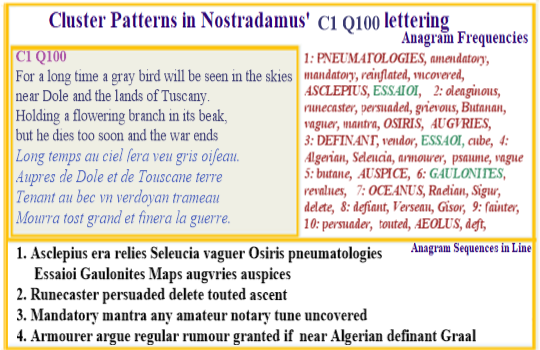 Analyses of all verses
Analyses of all verses
|
 Web Site
Web Site |
 All
Sefirots All
Sefirots |
Nostradamus C1 Q100:
Figures in ancient stories serve as ciphers for vast floods beginning in 21stC.
Copyright: Allan Webber, December 2015
 The
verse alongside is one of the first in which I uncovered evidence of Nostradamus use of
anagrams to build powerful links to ancient allusions.
The
verse alongside is one of the first in which I uncovered evidence of Nostradamus use of
anagrams to build powerful links to ancient allusions.
Although there is great strength in their relationships they don't make up the entire content of the verse. They are but a tool, referencing the pictures and ideas that will give detail to the present and future aspects of the verse.
The text of this verse combined with the content of the anagrams tell us that it relates to the period when the great floods that cover 70% of France for the next few centuries will begin to recede.
#Asclepius: Greek legendary rebirth figure
#Osiris: Egyptian legendary flood and rebirth figure.
#Essaoi: Jewish Sect at time of Jesus.
#Galonites: Jewish Sect at time of Jesus.
#auguries: Method of divination.
#auspices: Method of divination.
#pneumatologies: Studies of spiritual beings.
Extra Info: Discussion of this verse in my website pages.
The most potent line of verse concealing Nostradamus use of classical reference material is given below. It has been ignored by other analysts throughout the hundreds of years since Nostradamus' Prophecies were published. However I will demonstrate that what seems like an innocuous text holds great meaning via the anagrams it contains.
"Long
temps au ciel sera veu gris oiseau"
"For a long time a gray bird will be seen in the sky"
Centuries I, Quatrein 100, Line 1
An anagram is a word or phrase made by rearranging the order of a sequential group of letters in a text. My work on Nostradamus involves over twenty years of research into anagrams and their nature within his and other people's texts. The computer programs I have created allow me to state exactly how many anagrams there are and every place where they occur. A fuller discussion of my research is included in my other papers, but for now this provides a sufficient base from which I can present the evidence contained within the obscure and cryptic line above.
I begin with the section of the line starting from near the end of the second word ps au ciel s. This becomes psauciels by removing the blanks and then Asclepius by rearranging the letters. This is the only anagram of this name anywhere in the text.To most this revelation will appear underwhelming but the relevance of this word can change this view. Asclepius is a god-reference with strong links to a myth involving a gray bird.
Asclepius is a Greek figure who even today is linked to medicine and healing. The rod with the twisted serpent around it, which is the modern symbol for medicine, comes from the tales of Asclepius. It is a symbol of rebirth since the snake was considered as being Phoenix-like with qualities of reincarnation. The Phoenix is a legendary bird that rises anew from its own ashes.
There are 942 quatreins (verses) of four lines each in Nostradamus text which means there are over 3700 lines. The lines average about 45 letters in length so there are about 170,000 letter sets in which each search for anagrams is conducted. Therefore it can be stated that Asclepius occurs only once within the 170,000 places it might be found. This measure will give numerical relevance to the other figures given in these writings. However, low occurrence or singularity, doesn't prove that it isn't there by chance alone, it only establishes that it cannot easily be rationalised away as a product of chance. If this was all that could be offered then my arguments would fail but there is much more to indicate this word is not there by chance.
Using the same method of analysis I can take the sequence ris ois from gris oiseau in the above line and form Osiris. There is only one other instance of this anagram, so finding the two of them together is again interesting as the occurrence factor is also very low. The linking of these two identities in the same line can now be advanced beyond their rarity. They are linked by being metaphors for rebirth.
Osiris, like Asclepius, is a god associated with the rebirth of the land at the time of the Nile 's annual flood. The Egyptians linked another image to Osiris, that of a bird, the Bennu. This is a gray bird and it was the Egyptian version of the Phoenix. This bird is described as "the one who came into being by himself". It was believed to constantly rise renewed just like the sun.
The relevance of these connections to Nostradamus' visible text then lies in the Bennu. In most tales of flood there is a dove or similar bird that is released to search for land, the bird's long flights bring no hope until the day it returns with a twig held in its beak. It is a defining image that takes us directly to Noah and the flood but it also takes us to the antecedent tales from Sumer, Egypt and other places that tell of world-wide inundation.
Again, if this is all that exists in the line it is still easy to dismiss but there is much more of powerful significance within its lettering.
Nostradamus' reference to the ancient Star-Gods and the art of divination.
Asclepius, through Ophiucchus, and Osiris, through Orion, are Star Gods.This offers another connection via an anagram contained within this line. Using the line as a continuous loop, allows me to link the end lettering to the first letters of the line, like a snake biting its tail. Then Long temps au ciel sera veu gris oiseau becomes iseau Long temp. From the capitalised letters I can form pneumatologies, which is another anagram that only occurs here within Nostradamus' Prophecies.
The word pneumatology has several meanings all of which are similar:
- The doctrine or study of spiritual beings and phenomena, especially the belief in spirits intervening between humans and God.
- The Christian doctrine of the Holy Ghost.
- The belief in spiritual beings, as angels, between men and God.
So Osiris and Asclepius, the star gods are found in the same line that contains the description of their commonality; they are the Gods by whom the ancients sought intervention with the Universal Creator. In this instance the anagram is a plural form suggesting that more than one framework is involved, the ancient ones of the Egyptians and Greeks and the modern Christian form.
Although I believe I have presented a strong case already, it is not yet complete and there is at least one other highly significant anagram to disclose at this time. From Long temps au ciel sera veu gris oiseau we have auspice.There are five anagrams of this word within Nostradamus' text so it is not frequent but it certainly more common than the other words. It is its meaning that justifies its inclusion, especially now the other words have illuminated the way.
An AUSPICE is:
- a protection or support; patronage.
- a sign indicative of future prospects; an omen.
- an observation of and divination from the actions of birds.
The line refers to a grey bird flying for a long time. It is an omen and from its action we can draw unambiguous meanings. Here once more we have a very clear link to the visible line as well as to the newly uncovered words.
Osiris was a god of the earth and vegetation, who symbolized in his death the yearly drought and in his miraculous rebirth the periodic flooding of the Nile and the growth of grain. Rebirth and floods were linked in ancient times.
The third line of the verse in which all the above anagrams are located (line 1) confirms where this set of allegories will eventually lead.
"Tenant
au bec vn verdoyeant rameau"
"He carries a flowering branch in his beak"
Centuries I, Quatrein 100, L.3
Here we have a confirmatory image of the flood. Here is the small bird returning after a long flight with a frond in its beak. This is the link that Nostradamus makes with the past and through the anagrams we can see exactly on what stories these lines are based.
However, the above is enough to establish what I set out to show, namely that it is possible to give deep insight into a line of Nostradamus' text by uncovering the anagrams within it that are pertinent to the visible meaning of the line. And I did this in order to show that Nostradamus' own explanation of what he was doing is not easily discounted.
The anagrams in the rest of the verse don't develop this theme any further but instead they direct the reader to take a particular path in reading how it applies to the future. The major and least common anagram sequences are given above even though some will prove superfluous or poorly framed.